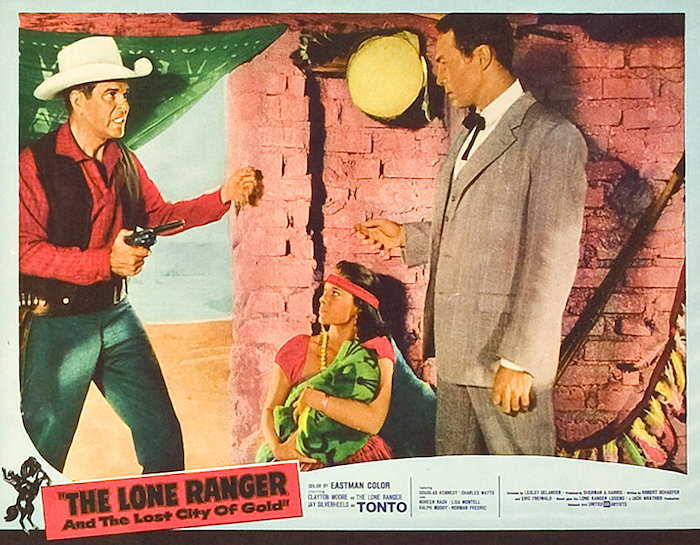Directed by Paul Landres
Produced by Jack Leewood
Screenplay by James Landis & Jack Thomas
Music by Paul Dunlap
Cinematography: Walter Strenge
Film Editor: Robert Fritch
Cast: Willard Parker (Clint Banister), Grant Williams (Greg Banister), Audrey Dalton (Susan Harvey), Douglas Kennedy (Maj. Phillip Harvey), June Blair (Florrie Stuart), Dabbs Greer (Doc Jansen), Barbara Heller (Amy Todd), Rayford Barnes (Finch), Tyler McVey (Henry Biggs), Lee Farr (Riff)
Clint Banister (Willard Parker) returns to Texas after the Civil War. Since he chose to fight for the Union instead of the Confederacy, he gets a chilly reception when he gets back his home town. He also learns that his younger brother (Grant Williams) is sheriff, and he’s running the town into the ground.
Paul Landres’ Lone Texan (1959) was the last of the Regalscope pictures. In the mid-50s, B producer Robert Lippert entered into an arrangement with 20th Century-Fox where his Regal Films, Inc. would produce a series of second features for the studio — two black and white CinemaScope pictures a month. They called the “process” Regalscope — black and white CinemaScope, nothing more. Lippert made around 50 Regalscope features between 1956 and 1959 — all of them cheap, most of them Westerns.
These films were made in about a week, often using sets left over from other pictures. Paul Landres was quite adept at making something out of nothing, with a string of excellent B movies to prove it — The Vampire, Hell Canyon Outlaws (both 1957) and The Return Of Dracula (1958). He worked largely in TV, where his efficiency was certainly appreciated. I sure wish he’d done more features.
Director Paul Landres: “On Lone Texan, we worked on the Western street over at Fox. I had six days on this show. I had a crane and I had lots of stuff that I was doing on the crane. I shot all day on that crane and every cut, every setup was unrelated. And the producer (Richard E. Lyons), who didn’t have the greatest experience, came to me and said ‘Paul, what are you doing? I can’t follow anything!’ Well, when it all went together, it made sense. You don’t shoot in continuity, and when you’re on that crane you shoot all the crane shots you need on the Western street throughout the picture.” I’m happy to report that Lyons eventually caught on to the whole moviemaking thing, and he went on to do pictures like Ride The High Country (1962) and Coogan’s Bluff (1968).
The cinematographer on that crane was Walter Strenge, who shot a number of the Reglalscope pictures, including the first one, Stagecoach To Fury (1956), which was nominated an Oscar for best B&W cinematography. You’d never know he was working on such a tight schedule — these films look good and use lots of long takes, which are so effective in early ‘Scope movies.
Paul Dunlap scored a number of the Regalscope movies, along with lots of other B pictures. It’s a shame he’s not better known. His music adds a lot to pictures ranging from Jack Slade (1953) to The Angry Red Planet (1959). Dunlap scored bigger films every once in a while, such as Big Jim McLain (1952) and Sam Fuller’s The Naked Kiss (1964).
The lovely Audrey Dalton has already appeared in Titanic (1953), Casanova’s Big Night (1954), Drum Beat (1954) and The Monster That Challenged The World (1957). In a couple years, she’d do William Castle’s Mr. Sardonicus (1961).
Willard Parker made plenty of B movies, and he’s as good here as he ever is. Grant Williams did this one a couple years after The Incredible Shrinking Man (1957), the movie he’s known for today. Douglas Kennedy and Dabbs Greer are always great to bump into.
The Regalscope pictures are hard to see, especially if you want to see ’em in their original 2.35 Regalscope framing. Very few are out there on Blu-Ray. Lone Texan is probably one of the better ones, thanks largely to its director and cast. It’s a nice mix of a number of common 50s Western themes — post-Civil War life, the relationship between brothers, a town run by a corrupt businessman, etc. There are certainly worse ways to 70 minutes. Recommended.













 This picture was clearly meant for kids. But there’s something about The Lone Ranger and Tonto I find more appealing the older I get. Their friendship, their fairness and their ongoing fight for justice are things we all could use some extra exposure to. I love this movie.
This picture was clearly meant for kids. But there’s something about The Lone Ranger and Tonto I find more appealing the older I get. Their friendship, their fairness and their ongoing fight for justice are things we all could use some extra exposure to. I love this movie.


